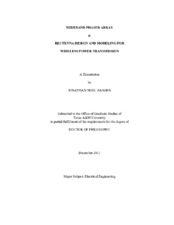| dc.description.abstract | Microstrip patch antennas are the most common type of printed antenna due to a myriad of advantages which encourage use in a wide range of applications such as: wireless communication, radar, satellites, remote sensing, and biomedicine. An initial design for a stacked-patch, broadband, dual-polarized, aperture-fed antenna is tested, and some adjustments are made to improve performance. The design goal is to obtain a 3 GHz bandwidth centered at 10 GHz for each polarization.
Once the single-element design is finalized, it is used in a 4x1 array configuration. An array increases the gain, and by utilizing variable phase-shifters to each element, the pattern can be electronically steered in a desired direction. The phase-can be easily adjusted. The result of this new phased array design is a wide bandwidth system with dual-polarization which can be electronically steered.
Rectennas (rectifying antennas) are used in wireless power transmission (WPT) systems to collect microwave power and convert this power into useable DC power. They find use in many areas such as space power transmission, RFID tags, wireless sensors, and recycling ambient microwave energy.
The ability to simulate rectenna designs will allow for an easier method of analysis and tuning without the time and expense of repetitive fabrication and measurement. The most difficult part of rectenna simulation is a good diode model, and since different diodes have dissimilar properties, a model must be specific to a particular diode. Therefore, a method of modeling an individual diode is the most critical part of rectenna simulation. A diode modeling method which is based on an equivalent circuit and compatible with harmonic balance simulation is developed and presented. The equivalent circuit parameters are determined from a series of S-parameter measurements, and the final model demonstrates S-parameters in agreement with the measured data.
An aperture-coupled, high-gain, single-patch rectenna is also designed and measured. This rectenna is modeled using the presented method, and the simulation shows good agreement with the measured results. This further validates the proposed modeling technique. | en |


